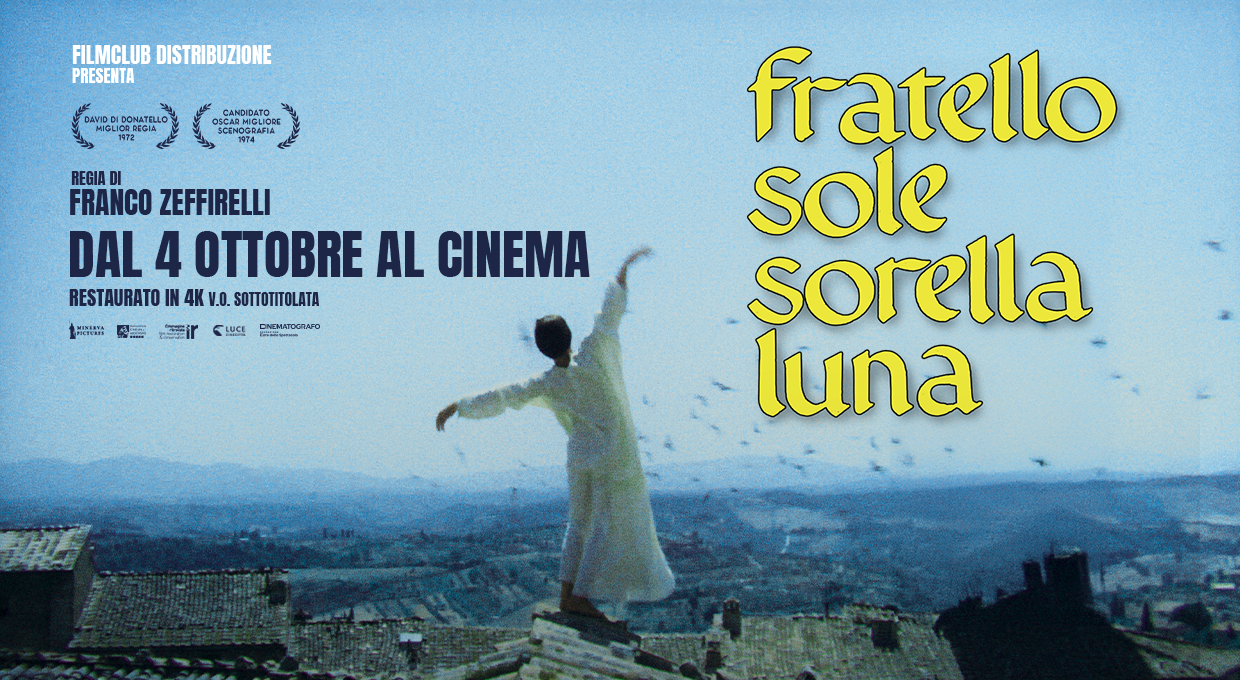On October 4th, the day dedicated to St. Francis, “Fratello Sole, Sorella Luna” returns to cinemas in a newly restored 4K version!
23 September 2024
On October 4th, 2024, and throughout the Franciscan month, Franco Zeffirelli‘s timeless masterpiece, Fratello Sole, sorella Luna, will return to the big screen. Distributed by FilmClub Distribuzione and Minerva Pictures with the support of Fondazione Ente dello Spettacolo, the film will be presented in a newly restored 4K version. This event coincides with the feast day of Saint Francis of Assisi, the Patron Saint of Italy.
Italian audiences will have the chance to enjoy this masterpiece in an unprecedented way: the 4K restoration, carried out by Paramount Pictures at Immagine Ritrovata in Bologna with the contribution of Istituto Luce Cinecittà and the Ministry of Culture, features the international cut, presented in its original version with Italian subtitles. This version, with a screenplay by Suso Cecchi d’Amico, Lina Wertmüller, and Zeffirelli himself, accompanied by Donovan‘s iconic score, offers extraordinary visual quality, enhancing Zeffirelli’s artistic vision and cinematography. The restored film was first showcased at the Quirinale Palace last March, in the presence of President Sergio Mattarella.
Fratello Sole, sorella Luna, which won a David di Donatello for Best Direction and was nominated for an Oscar for Best Art Direction, has been celebrated for its profound beauty and moving portrayal of Saint Francis’ life. Featuring the unforgettable performances of Graham Faulkner and Judi Bowker, the film is a poetic and visually sublime reflection on spirituality, love, and the beauty of nature. The meticulous 4K restoration offers impeccable image quality, allowing fans to relive this classic film in an enhanced and immersive way.
The restored version of Fratello Sole, sorella Luna will be shown in selected theaters across Italy as part of an event release. The film’s distribution is managed by FilmClub Distribuzione, in collaboration with Minerva Pictures and with the support of Fondazione Ente dello Spettacolo. The national release will be preceded by two exclusive preview screenings.
On September 24th, the film will be screened at the Vatican Film Library in a high-profile private event attended by prominent figures from the Catholic world, politics, media, and the audiovisual industry. The screening will be introduced by Paolo Ruffini, Prefect of the Vatican Dicastery for Communication, Mons. Davide Milani, President of Fondazione Ente dello Spettacolo, and Gianluca Curti, President and CEO of Minerva Pictures.
On October 1st at 7:30 p.m., the film will be previewed for the public at the Barberini Cinema in Rome. Mons. Davide Milani and Gianluca Curti will once again introduce the screening.
FURTHER READING
Fratello Sole, sorella Luna.
Enrico Baragli, Rivista del Cinematografo, No. 7, July 1972.
Not a historical reconstruction, let alone a documentary, the film freely reinterprets the decade of life that spans from the departure of Francesco, a twenty-year-old, to war against Perugia, to the meeting of the Poverello, at thirty, with Innocent III in Rome. It is a reinterpretation with an eye and a mind on today’s society and the Church: bourgeoisified—therefore: inhumane and anticlerical—like, if not more than, the world and the Church of the 13th century; thus still open to contestation. Hence, like in Cavani, but in more allegorical than realistic tones, we see a globally protesting Francesco, and on two fronts. On the social-secular level, he is an idealized hippie. (…) In the ecclesiastical aspect, Zeffirelli’s Francesco presents himself as the model Christian in this post-Vatican II Church: to be liberated, yes, from the historical incrustations that still show it as more aligned with Mammon and power than a witness to the Beatitudes, but not to be demolished with corrosive polemics or disciplinary rebellion. Forming a spontaneous group with his young friends, he does not hesitate, as a layman, to use (as we say today) his prophetic charisma by proposing a return to the integral Gospel, “sine glossa”; but while distinctly separating the unworthiness of people from the legitimacy of their function, he solicits from all levels of the established hierarchy, up to the Roman one, a verification of his charisma.
(…)
A set designer and theatrical director, especially renowned for his Shakespearean works, Zeffirelli essentially remains the same when he eventually turns to film directing. Mastering the craft, learned from the school of Rossellini, De Sica, Visconti, Pietrangeli, and Antonioni, he illustrates and adorns literary texts with images—albeit cinematic ones, since the technical medium provides them with their own internal time—thus arriving at works like The Taming of the Shrew (1967) and Romeo and Juliet (1968) of excellent, indeed refined style, but with a theatrical structure. This Saint Francis is no exception. (…) There’s no denying it: it’s a superb spectacle that is sure to receive an excellent reception from the audience. And this will be no small merit of Zeffirelli.
